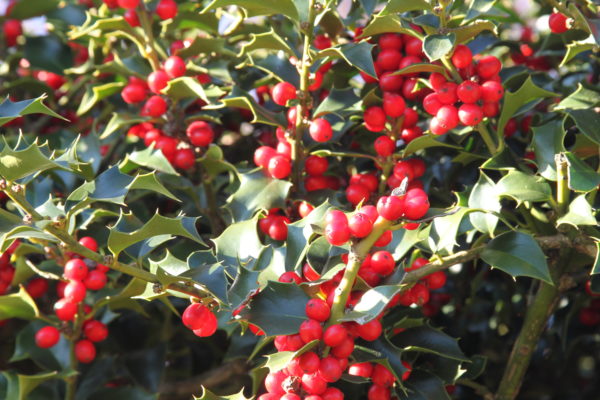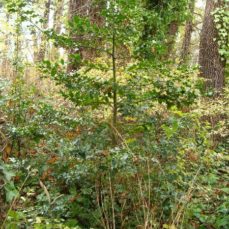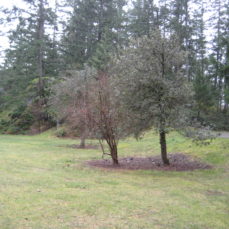English Holly (Ilex aquifolium)

Photo credit: John Ruter, University of Georgia, Bugwood.org
ID Characteristics
General: English holly is a hardy perennial evergreen shrub with a single trunk or multiple stems. It is often used in landscapes as well as in decorations, floral decorations and as an ornamental during Christmas, hence its nickname “Christmas holly”. English holly plants can live over 250 years, and 10 year-old plants show a low mortality rate and accelerated growth.
Flowers: Small, white, inconspicuous and smell slightly sweet.
Stem: Erect, with spreading branches. Young plants have green bark, which turns smooth and grey-silver at maturity. English holly is a tall shrub (2 – 5 m tall).
Leaves: Dark green, glossy, leathery, alternate, evergreen and egg-shaped, 2.5 – 6 cm long. Young leaves have stiff, sharp spines on the leaf margins; mature leaves may have smooth leaf margins and fewer spines, if at all.
Fruits: Round, smooth, bright red or orange berries, 7 – 8 mm wide. Caution: Berries are poisonous to humans and pets.
Seeds: Berries grow in clusters and contain 2 – 8 seeds each.
Roots: Woody and long.
Similar Species
Native
Tall Oregon grape (Mahonia aquifolium) is also an evergreen shrub and boasts similar leaf characteristics that English holly does, with sharp spines along the leaf margins. However, tall Oregon grape leaves are arranged opposite one another up the stem, whereas English holly leaves are alternate. Tall Oregon grape also has a longer blooming period, displaying bright yellow flowers; moreover, it is typically shorter than English holly, reaching up to 2.5 m in height.

Exotic (non-native, non-invasive)
San Jose holly (Ilex x aquipernyi ‘San Jose’) closely resembles English holly, without its invasive tendencies. Both hollies have very similar leaf shapes and berries, but the San Jose variety tends to grow a bit taller than English holly (up to 6 m tall).

Habitat and Origin
English holly originates from the British Isles and from Southern and Central Europe.
English holly is adaptable to a wide range of soil, moisture, temperature and light conditions. It is often found in mixed deciduous forests, wetlands and near residential areas. It can survive in both sunny and shady conditions and grows best in sandy or well-drained soils.
How it Spreads
English holly reproduces by seed as well as vegetatively. One shrub can produce 120,000 seeds annually. It can resprout from cut stumps, suckering (sending up shoots from the roots) and layering (growing the roots from where stems touch the ground).
Long-distance dispersal can occur through birds that eat the English holly berries. Short-distance spread occurs by vegetative reproduction. English holly is also spread by nursery sales, as it is a popular holiday decoration.
Impacts
Health:
- Berries are poisonous to humans and pets.
Ecological:
- Forms dense monocultures that push out native plants; supresses germination and growth.
- Creates shade that deprives native plants of light.
- Roots hog nutrients and water, which prevents other plants from growing in its vicinity.
- Modifies soil conditions by adding a significant amount of organic matter and sulfur, making it difficult for native plants to thrive.
- Flammable leaves pose a fire risk.
Stop the Spread
English holly is abundant in certain portions of the Sea to Sky region (i.e., in Squamish and south), but has not yet infested all potential habitats. The goal is to contain the spread of English holly to ISMA 1.
Learn to identify English holly: Use the images presented in this profile page to learn how to identify English holly.
What to do if you spot it: You can report any English holly sighting by visiting our reporting page.
DO:
- Regularly monitor properties for weed infestations.
- Ensure soil and gravel are free of English holly before transporting.
- Ensure plants (particularly flowering heads, berries or root fragments) are bagged or covered to prevent spread during transport to designated disposal sites (e.g. landfill).
DO NOT:
- Purchase English holly from nurseries for garden use.
- Plant English holly.
- Unload, park, or store equipment or vehicles in infested areas; remove plant material from any equipment, vehicles, or clothing used in such areas and wash equipment and vehicles at designated cleaning sites before leaving infested areas.
Control
Mechanical Control
- Hand-pull small plants when the soil is moist. Larger plants may be pulled or dug out using mechanical tools, or excavated.
- Ensure the entirety of the root system is removed whenever possible, but be prepared to treat the site repeatedly.
- For larger plants, it may be helpful to cut down the above-ground vegetation before digging the roots out.
- Remove the roots and stems from the site and dispose of them to prevent the cut holly from suckering and re-rooting.
- Wear eye protection, long pants, long sleeves, sturdy footwear, and work gloves when working around English holly to avoid scratches or injury from the prickly leaves.
- It is best to remove holly before the berries mature; otherwise, make sure you plan for berry removal.
Chemical Control
- The application of herbicides such as glyphosate, imazapyr or triclopyr to cut stumps is an effective chemical control method. Glyphosate can also be applied using stem injection or foliar application.
- Where permitted, glyphosate can also be applied using stem injection or foliar application.
- However, English holly’s preference for riparian habitats makes using chemical control extremely difficult.
We recommend that any herbicide application is carried out by a person holding a valid BC Pesticide Applicator Certificate. Before selecting and applying herbicides, you must review and follow herbicide labels and application rates; municipal, regional, provincial and federal laws and regulations; species-specific treatment recommendations, and site-specific goals and objectives.
Biological Control
There is no biocontrol agent available at this time.
Sea to Sky Distribution
English Holly Factsheet
Having trouble viewing the factsheet? Don’t worry, all the information is included on this page. You can also contact us with any questions.
Additional Resources
References
- Coastal Invasive Species Committee, English Holly
- eFlora, Tall Oregon Grape
- Fraser Valley Invasive Species Society, English Holly
- Invasive Plants Atlas, English Holly
- Invasive Species Council of British Columbia, English Holly
- Invasive Species Council of Metro Vancouver and Metro Vancouver Regional District, Best Management Practices for English Holly in the Metro Vancouver Region
- King County, English Holly identification and control
- Noxious Weeds Control Board of Washington, Feral Holly (Ilex aquifolium)
- University of California Weed Research and Information Center, English holly (excerpt of Weed Control in Natural Areas in the Western United States)











